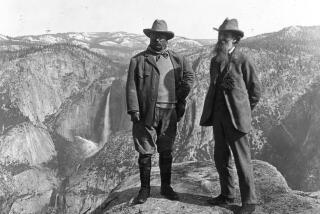Horace M. Albright, Pioneer of National Park Service, Dies
- Share via
Horace Marden Albright, co-founder of the National Park Service and its second director, died Saturday at the Chandler Convalescent Home in North Hollywood at the age of 97. He had been ill about three weeks and a relative said death resulted from “his heart wearing out.”
“His footprints are on the United States and the world because all other national park systems are modeled on the one he built,” said Sierra Club officials in 1986 when the organization presented him its John Muir Award for his role in organizing the national agency and establishing such national parks as Grand Canyon, Zion, Bryce Canyon and the Great Smoky Mountains.
Previous winners of the annual award include Supreme Court Justice William O. Douglas, oceanographer Jacques Cousteau and nature photographer Ansel Adams.
Albright, a native of the Sierra foothill town of Bishop, also was a recipient of the nation’s highest civilian honor, the Medal of Freedom, which was conferred on him by President Jimmy Carter in 1980.
After graduating from the University of California at Berkeley, Albright was working in the Department of the Interior in 1915 when he teamed with wealthy mountaineering enthusiast Stephen Mather, a friend, to press for legislation to establish a federal bureau to administer the government’s loose collection of parklands. A year later, during the Woodrow Wilson administration, the park service was formed by Congress.
Mather was appointed the service’s first director and Albright assistant director. But in less than a year, Albright was running the fledgling agency because Mather suffered an illness that sidelined him for two years.
When Mather finally stepped down in 1929, Albright became director and served in the post until he resigned to join the American Potash Co. in 1933. Even then, he retained a close association with the agency and remained active in conservation efforts throughout his life.
Vast Role of Influence
Today, the park service maintains and manages the nation’s 79.5 million square acres of national lands.
Albright, who had a sharp memory for dates and places, recalled that as a young man he once met Muir, the legendary naturalist. While studying in Berkeley in 1913, he said, he visited a Sierra Club meeting in San Francisco. “John Muir was there, I shook hands with him,” Albright recalled. “He was friendly, a nice old fellow. He died the next year.”
As a leading executive of the park service, Albright worked to stake claims on wilderness areas facing private development, then quickly opened them to the public. “In our day, “ he said in an interview a few years ago, “we had to have people in the parks, because that was the way Congress judged the parks--on how many people used them.”
Albright was co-author of several books on the park service, the most recent published last year. It was called “The Birth of the National Park Service: The Founding Years,” and was written in collaboration with Pulitzer Prize-winning author Robert Cahn.
After retiring from his second career in the business world at 72, Albright moved to the San Fernando Valley to be near his daughter, Marian Schenck, and her husband, Ross. His wife Grace, whom he married in 1915, died six years ago.
Concern for the Future
In 1980, Albright told a Times writer he feared the entire American Southwest someday would be enveloped by smog and he added:
“That won’t prevent living here. But it won’t be such good living. I can’t help but worry about the future. I have nine (great) grandchildren. I wonder what’s going to happen to them.”
Beside his daughter and great-grandchildren, survivors include a grandson and three granddaughters, one of whom is married to a park service ranger. A nephew, Stanley T. Albright, presently is associate director of the service’s park operations.
Funeral plans are pending.
More to Read
Sign up for Essential California
The most important California stories and recommendations in your inbox every morning.
You may occasionally receive promotional content from the Los Angeles Times.












